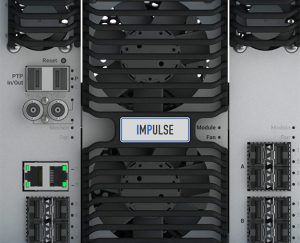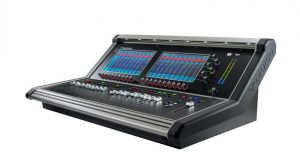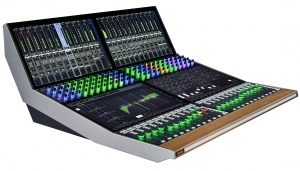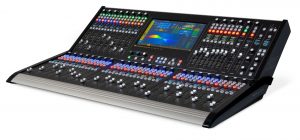Tech Focus: Audio Consoles, Part 2 — A Look at Mixing Units for Remote Production
Increased diversity in sizes, functionality marks this relatively small category
Story Highlights
Audio-mixing consoles for remote broadcast production represent a relatively rarefied category at the high end of the market, but there’s increasing diversity within the group, thanks to growing demand for consoles of various sizes and functionality. Here’s an overview of the leading contenders.
Click here for Tech Focus: Audio Consoles, Part 1 — Design Evolves To Meet New Exigencies
Calrec
The introduction of Calrec’s ImPulse core, which is compatible with existing Apollo and Artemis control surfaces, offers users a native IP AES67- and SMPTE 2110-compliant backbone and a fully defined upgrade path as they transfer to IP infrastructures. Designed for broadcasters already producing live content in immersive formats over such platforms as MPEG-H and Dolby Atmos, ImPulse includes 3D immersive path widths and panning, with full monitoring and metering, height and 3D-pan controls. It is fully scalable, with a flexible upgrade path and DSP expansion capacity for changing requirements.
Besides launching ImPulse, Calrec recognizes that, as the industry converges on IP workflows, upgrade plans need to be defined because moving to an IP infrastructure requires careful planning. In response, Calrec has introduced Gateway technologies to make the transition smoother and allow more flexibility at large, multiple-production events where Hydra2 and IP are being used concurrently. Calrec supports its customers at every stage in the move to IP. Its H2-IP gateway and the AoIP modular I/O controller card, both of which are SMPTE 2110/AES67-compatible, are designed to help all its customers — including sports broadcasters — bridge the gap to IP workflows. They provide an interface between Calrec Hydra2 networks and an AoIP network and provide control capability to allow control data and audio labels to be passed in both directions.
The company’s Type R modular, expandable, IP-based system uses standard networking hardware and soft panels, which can be tailored to operator needs. It can also operate as a headless console; in fact, there is a rise in demand for more virtualized production, including at-home production and headless consoles. Calrec’s Type R and VP2 headless consoles and RP1 Remote Production core can help broadcasters streamline workflows, reduce downtime on consoles, improve cost efficiency, and expand variety of coverage.
Calrec’s Connect web application manages IP streams regardless of registration/discovery protocol and provides access to in-depth configuration, extracting the information and providing a simple interface for day-to-day management by production staff. calrec.com/
DiGiCo
DiGiCo has expanded its S Series of compact digital consoles with the S31. A larger version of the popular S21 console, it features an expanded work surface with 10 additional faders for more control and a third 10-in. multi-touch screen, with 24 mic inputs and 12 line outputs on the rear of the console for straightforward audio connection. It also has two slots for any DiGiCo Multichannel Interface (DMI) card.
The new compact 2RU Orange Box is an audio-format converter with multiple options, allowing use of DMI cards to create audio paths over a variety of interfaces. With two PSUs for redundancy and two slots to accommodate any of the 10 current interfaces available (Dante, Hydra2, BNC, Cat 5, Optocore, Aviom, AES, ADC, DAC, and Waves/SoundGrid), the Orange Box allows conversion of almost any audio format to another. www.digiconsoles.com/
Lawo
Lawo consoles are IP-ready and support current and evolving industry standards for audio, video, and data format interoperability. The mc² Series mixing consoles — the mc²96 Grand Production Console, optimized for IP production environments; the mc²56 and new mc²56mkIII, available with optional surfaces that provide extra free controls or dual faders; and the all-in-one mc236 — are offered in multiple configurations with physical console surfaces, channel capacity, and frames optimized for everything from mobiles and flypacks to large production complexes. Lawo also offers a full range of solutions for remote-production and automated mix applications, including standalone cores. The mc2 Micro Core universal networked audio engine, the Compact Engine AES67 audio node with on-board DSP, and the Power Core 1RU IP-based mix engine with modular I/O options can perform all audio mixing and routing functions under remote control of vision mixers or third-party automation systems.
Lawo’s A__UHD Core, an ultra-high–density IP DSP engine for mc² consoles, uses the IP network as an extension of the console core’s backplane and thus can be located anywhere on the network. Its ultra-high processing density with more than 1,000 mc² fully featured DSP channels can be used by a single mc² console for coping with the most challenging productions or can be shared by up to four consoles.
Multiple stagebox I/O offerings support IP interfacing of analog and digital sources for remote-production applications. In addition to its DALLIS modular frames, Lawo also offers the A__line of AoIP interfaces for managing analog, AES3, MADI, and RAVENNA/AES67 audio connections, including functionality for remote mic pre control and operation of audio-mix functions from a remote location using a browser-based interface that can be customized for specific workflows. All of Lawo’s consoles, cores, stageboxes, control software, and Nova Series routers offer multiple configuration options with protocols supported for automation and studio/remote management applications, including the VSM Virtual Studio Manager broadcast-control and -monitoring system and SOUL (Seamless Orchestration and Unification Layer), the company’s newest offering for control of networked production infrastructures. www.lawo.com/
Stage Tec
The new AVATUS IP console officially launched at the end of June. An innovative, high-performance mixing console suited to broadcast applications, it represents a compromise between tablet computers and the established, tried and tested AURUS. The console offers color coding for control elements, such as encoders and faders, as well as user guidance without deep hierarchies. A flexible user interface is provided by 21-in. FHD multitouch screens; a fixed center section is no longer necessary. Removable PoE-powered metering screens underline the modularity of the system. AVATUS is available with 12 to 96 faders and in various hardware versions.
Stage Tec’s NEXUS audio network offers interfaces to all standards and also covers the current IP formats with the latest RIF67/XFIP boards (JT-NM Tested). The boards are based on DirectOut’s AES67 IO module and support the AES67/RAVENNA protocol. They also comply with ST 2110-30 and 2022-7 standards, which support interoperability in audio networks. On the control side, NEXUS offers an Ember+ gateway via the NEXUS XACI board in addition to an in-house system.
The AURUS platinum flagship multiformat production console is available in eight to 96 faders and per-setup scalable-core resources featuring 218-822 channels at 128-32 mix busses (capacities at 48 kHz; 96 kHz is also supported with lowered channel count). Working in 5.1 and 7.1 surround, it can handle stereo and mono simultaneously through multiple separate bus configurations. Different down/upmix capabilities are available both in the consoles and in the NEXUS network. A brand-new feature is the Waves integration. The Waves plugins can be connected directly to the AURUS scene automation system. Thanks to the AES67/RAVENNA connection and Dante interfaces from NEXUS, AURUS platinum can be integrated into IP networks. www.stagetec.com/
Studer
Studer’s Vista Infinity-powered broadcast mixing consoles — now including the Vista V, X, and 5Black Edition models — retain the Vistonics and FaderGlow user interface from previous versions in the Vista line, providing control of 1,000 or more audio DSP channels and more than 5,000 inputs and outputs. At the heart of the system is a range of Infinity DSP cores, which use CPU-based processors to provide huge numbers of DSP channels for large-scale, high-resolution audio processing and mixing. This offers significant advantages, with CPU processing providing a scalable system, faster development of new signal-processing designs, larger channel counts, full-system redundancy without a single point of failure, and the possibility of running third-party algorithms.
The Infinity DSP engine now comes in six versions: Core 300/600/1000, Compact Infinity Core 300/6000, and the Compact Core link Card/COTS server version, all providing A-Link high-capacity fiber digital audio interfaces, scalable to more than 5,000 I/O. The high-density D23m I/O system is used to break out these A-Link connections to standard analog, digital, and video interfaces. The A-Link interface also provides direct connection to the Riedel MediorNet and Evertz routers, allowing multiple Infinity systems to be connected and simplifying complex infrastructures. www.studer.ch/
SSL
System T is a fully networked broadcast-audio production environment, across an IP-based, network-native control and audio infrastructure. System T has a highly configurable architecture, and its range of hardware and software control interfaces can be distributed anywhere across a network, including specific offerings for flypack systems and remote-production installations. Control interfaces include the flagship S500 modular large-format console and the flypack-ready S500m, which delivers the same feature set as the S500 in a form factor more than 25% lighter and with turnkey flight-case solutions available.
The compact S300 provides either 16+1 or 32+1 faders, presenting the power and versatility of System T in a streamlined console layout that remains intuitive for operators at a wide range of skill levels.
The Tempest Control Rack (TCR) is suited for environments where the power of a broadcast audio mixer is required but a traditional console is not, such as automated broadcast environments and mobile/remote broadcast applications. Individual remote fader tiles and PC-based control software complete the System T control interface offering. Any surface variant can connect to either Tempest Processor Engine: a T25 (256 fully processed paths at 48 kHz) or a T80 (800 fully processed paths at 48 kHz). In addition, up to three consoles or control interfaces can access a single or fully mirrored redundant pair of Tempest processor engines. System T’s inherent AoIP infrastructure provides inbuilt Dante, AES67, and SMPTE 2110-30 audio-transport capability. A range of interfaces are available to connect to existing I/O infrastructure. www.solidstatelogic.com/
Wheatstone
The WheatNet-IP audio network, an AES67-compatible AoIP network environment, offers a wide selection of devices, software, and console surfaces. Its IP audio consoles range from the large-format IP-64 to the new compact Strata 32, which packs 64 channels and the latest IP audio innovation into a 40-in. linear frame that fits remote vans and sports venues as well as budgets under $75,000. The IP audio network offers development software tools for creating virtual interfaces and applications as well as fully developed virtual mixers.
The Virtual Dimension Three is a fully functioning standalone virtual console that can be used at sports venues as an adjunct to a physical Dimension Three console at the studio, for example. Also unique to the WheatNet-IP audio network is an AoIP appliance that solves the missing link between the sports venue and the main studio.
SwitchBlade is a 1RU appliance that combines AoIP logic control with SIP connectivity and codec bandwidth optimization for transporting live feeds plus the control logic critical for full studio operation between locations. Previously, logic control ended at the studio walls. With SwitchBlade, operators can now turn mics on or off, trigger IFBs, set levels, and make adjustments to devices at the sports venue from the main studio and combine both locations into one seamless operation. www.wheatstone.com/




